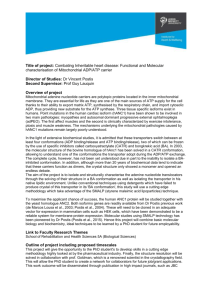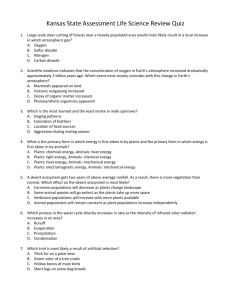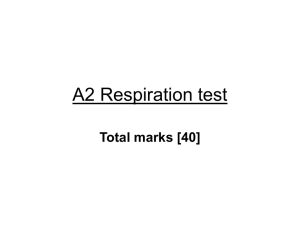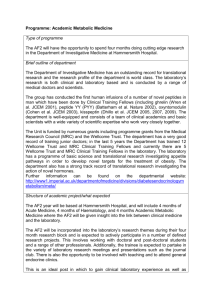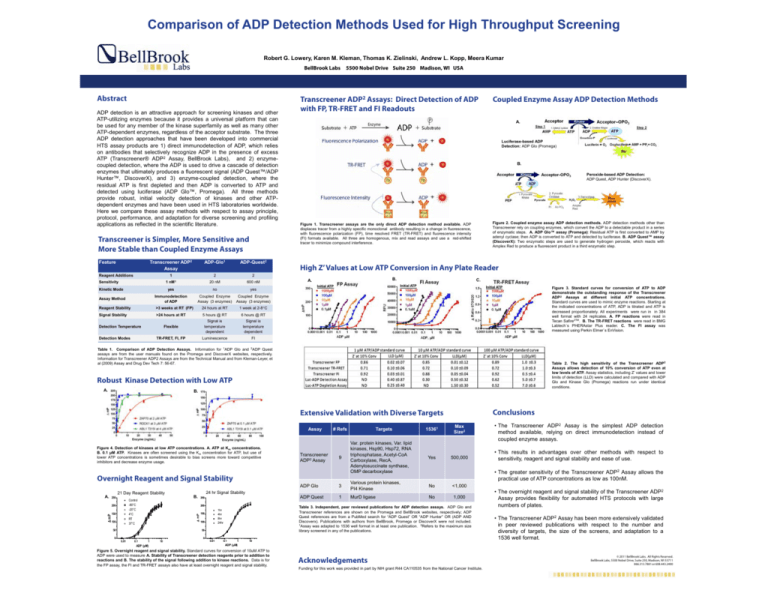
Comparison of ADP Detection Methods Used for High Throughput Screening
Robert G. Lowery, Karen M. Kleman, Thomas K. Zielinski, Andrew L. Kopp, Meera Kumar
BellBrook Labs
Abstract
ADP detection is an attractive approach for screening kinases and other
ATP-utilizing enzymes because it provides a universal platform that can
be used for any member of the kinase superfamily as well as many other
ATP-dependent enzymes, regardless of the acceptor substrate. The three
ADP detection approaches that have been developed into commercial
HTS assay products are 1) direct immunodetection of ADP, which relies
on antibodies that selectively recognize ADP in the presence of excess
ATP (Transcreener® ADP2 Assay, BellBrook Labs), and 2) enzymecoupled detection, where the ADP is used to drive a cascade of detection
enzymes that ultimately produces a fluorescent signal (ADP Quest™/ADP
Hunter™, DiscoverX), and 3) enzyme-coupled detection, where the
residual ATP is first depleted and then ADP is converted to ATP and
detected using luciferase (ADP Glo™, Promega). All three methods
provide robust, initial velocity detection of kinases and other ATPdependent enzymes and have been used in HTS laboratories worldwide.
Here we compare these assay methods with respect to assay principle,
protocol, performance, and adaptation for diverse screening and profiling
applications as reflected in the scientific literature.
Transcreener is Simpler, More Sensitive and
More Stable than Coupled Enzyme Assays
Transcreener ADP2
Assay
ADP-Glo1
ADP-Quest2
Reagent Additions
1
2
2
Sensitivity
nM1
Feature
1
20 nM
600 nM
yes
no
yes
Assay Method
Immunodetection
of ADP
Coupled Enzyme
Assay (3 enzymes)
Coupled Enzyme
Assay (3 enzymes)
Reagent Stability
>3 weeks at RT (FP)
24 hours at RT
1 week at 2-8°C
Signal Stability
>24 hours at RT
5 hours @ RT
6 hours @ RT
Flexible
Signal is
temperature
dependent
Signal is
temperature
dependent
TR-FRET, FI, FP
Luminescence
FI
Detection Modes
Transcreener ADP2 Assays: Direct Detection of ADP
with FP, TR-FRET and FI Readouts
Coupled Enzyme Assay ADP Detection Methods
A.
Luciferase-based ADP
Detection: ADP Glo (Promega)
B.
Peroxide-based ADP Detection:
ADP Quest, ADP Hunter (DiscoverX).
Figure 2. Coupled enzyme assay ADP detection methods. ADP detection methods other than
Transcreener rely on coupling enzymes, which convert the ADP to a detectable product in a series
of enzymatic steps. A. ADP Glo™ assay (Promega): Residual ATP is first converted to AMP by
adenyl cyclase; then ADP is converted to ATP and detected by luciferase. B. ADP Quest™ assay
(DiscoverX): Two enzymatic steps are used to generate hydrogen peroxide, which reacts with
Amplex Red to produce a fluorescent product in a third enzymatic step.
Figure 1. Transcreener assays are the only direct ADP detection method available. ADP
displaces tracer from a highly specific monoclonal antibody resulting in a change in fluorescence,
with fluorescence polarization (FP), time resolved FRET (TR-FRET) and fluorescence intensity
(FI) formats available. All three are homogenous, mix and read assays and use a red-shifted
tracer to minimize compound interference.
High Z’ Values at Low ATP Conversion in Any Plate Reader
Kinetic Mode
Detection Temperature
5500 Nobel Drive Suite 250 Madison, WI USA
B.
A.
C.
Initial ATP
Initial ATP
Initial ATP
Table 1. Comparison of ADP Detection Assays. Information for 1ADP Glo and 2ADP Quest
assays are from the user manuals found on the Promega and DiscoverX websites, respectively.
Information for Transcreener ADP2 Assays are from the Technical Manual and from Kleman-Leyer, et
al (2009) Assay and Drug Dev Tech 7: 56-67.
Table 2. The high sensitivity of the Transcreener ADP2
Assays allows detection of 10% conversion of ATP even at
low levels of ATP. Assay statistics, including Z’ values and lower
limits of detection (LLD) were calculated and compared with ADP
Glo and Kinase Glo (Promega) reactions run under identical
conditions.
Robust Kinase Detection with Low ATP
A.
B.
Conclusions
Extensive Validation with Diverse Targets
Assay
Figure 4. Detection of kinases at low ATP concentrations. A. ATP at Km concentrations.
B. 0.1 μM ATP. Kinases are often screened using the Km concentration for ATP, but use of
lower ATP concentrations is sometimes desirable to bias screens more toward competitive
inhibitors and decrease enzyme usage.
Transcreener
ADP2 Assay
# Refs
9
Overnight Reagent and Signal Stability
21 Day Reagent Stability
250
Control
-80°C
-20°C
4°C
RT
37°C
ΔmP
200
150
100
100
50
0
0.01
0.1
1
ADP (µM)
10
0.01
Var. protein kinases, Var. lipid
kinases, Hsp90, Hsp72, RNA
triphosphatase, Acetyl-CoA
Carboxylase, RecA,
Adenylosuccinate synthase,
OMP decarboxylase
Max
Size2
Yes
500,000
0.1
1
• The Transcreener ADP2 Assay is the simplest ADP detection
method available, relying on direct immunodetection instead of
coupled enzyme assays.
• This results in advantages over other methods with respect to
sensitivity, reagent and signal stability and ease of use.
• The greater sensitivity of the Transcreener ADP2 Assay allows the
practical use of ATP concentrations as low as 100nM.
3
Various protein kinases,
PI4 Kinase
No
<1,000
ADP Quest
1
MurD ligase
No
1,000
Table 3. Independent, peer reviewed publications for ADP detection assays. ADP Glo and
Transcreener references are shown on the Promega and BellBrook websites, respectively; ADP
Quest references are from a PubMed search for “ADP Quest” OR “ADP Hunter” OR (ADP AND
Discoverx). Publications with authors from BellBrook, Promega or DiscoverX were not included.
1Assay was adapted to 1536 well format in at least one publication. 2Refers to the maximum size
library screened in any of the publications.
1hr
4hr
8hr
24hr
150
Targets
15361
ADP Glo
24 hr Signal Stability
250
200
50
0
B.
Δ mP
A.
Figure 3. Standard curves for conversion of ATP to ADP
demonstrate the outstanding response of the Transcreener
ADP2 Assays at different initial ATP concentrations.
Standard curves are used to mimic enzyme reactions. Starting at
the indicated concentrations of ATP, ADP is titrated and ATP is
decreased proportionately. All experiments were run in in 384
well format with 24 replicates. A. FP reactions were read in
Tecan Safire2TM. B. The TR-FRET reactions were read in BMG
Labtech`s PHERAstar Plus reader. C. The FI assay was
measured using Perkin Elmer`s EnVision.
10
• The overnight reagent and signal stability of the Transcreener ADP2
Assay provides flexibility for automated HTS protocols with large
numbers of plates.
• The Transcreener ADP2 Assay has been more extensively validated
in peer reviewed publications with respect to the number and
diversity of targets, the size of the screens, and adaptation to a
1536 well format.
ADP (µM)
Figure 5. Overnight reagent and signal stability. Standard curves for conversion of 10uM ATP to
ADP were used to measure A. Stability of Transcreener detection reagents prior to addition to
reactions and B. The stability of the signal following addition to kinase reactions. Data is for
the FP assay, the FI and TR-FRET assays also have at least overnight reagent and signal stability.
Acknowledgements
Funding for this work was provided in part by NIH grant R44 CA110535 from the National Cancer Institute.
© 2011 BellBrook Labs. All Rights Reserved.
BellBrook Labs, 5500 Nobel Drive, Suite 250, Madison, WI 53711
866.313.7881 or 608.443.2400



